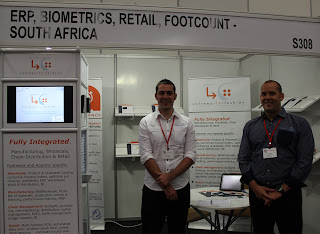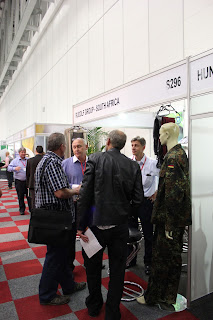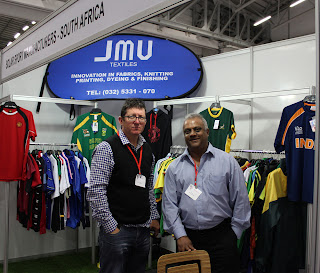Source Africa Trade Show: Africa is rising
Africa is the world’s next sourcing destination, was the
message of the recent Source Africa trade show and seminars in Cape Town.
Among the more than 150 exhibitors were several country and
South African industry stands that promoted the manufacturing capabilities of
their industries to the more than 1 000 registered visitors, including top
international retailers.
 |
| Peter Sunderland of Fram/Wayne and Miles O'Brien of Jordan & Co were part of the SAFLEC exhibit |
During business seminars organised by the American Apparel
and Footwear Association (AAFA), the benefits and challenges of manufacturing
in Africa were discussed, and some solutions offered.
There is growing testament that South Africa is a future destination
as a market and there is a growing interest in doing business in this part of
the world, said Steve Lamar, executive vice-president of AAFA, whose members
account for 75% of the apparel sold in the US.
The Chinese domestic market is growing so fast — at 7% per
annum — that Chinese factories will eventually only have the capacity to
manufacture for their own market, predicted Philip Krawitz.
 |
| The Apparel Manufacturers of South Africa stand was popular |
“According to an IMF report 6 of the 10 fastest growing
economies in the world are in Sub-Saharan Africa — after Asia, Africa is the
fastest growing region. Our time IS coming!” Lionel October, DG of the
Department of Trade and Industry (DTI) told delegates. After years of reporting
job losses, the South African apparel industry for the first time reported a
growth of 12 000 jobs.
 |
| Albertina Bay, Dylan and Travis Ludlow introduced the Albertina Bay softwear for retailers, including the latest footcount technology |
Apparel and textile are identified as priority sectors in
the recent Department of Trade and Industry (DTI) Industrial Policy Action
Plan, with several incentives to grow the sector further.
And South African companies have the ability to make the
most advanced technical textiles required — including for the sport and outdoor
markets, said Tony Wardle, COO of Gelvenor Textiles, whose KwaZulu Natal
factory have ISO 14001 certification for ethical and sustainable manufacturing.
 |
| Hans Lourens (middle, facing) explain the benefits of the finishes supplied by his Rudolf Chemicals factory for technical textiles |
Since 2009 African apparel imports into the US has grown
550% to $270-bn in 2011 — creating 300 000 jobs in African factories, said Erica
Barks-Ruggles, Consul General of the US in Cape Town. African imports into the
US has grown from $2.1-bn to $4.5-bn due to AGOA, and major retailers like Gap,
Levis and Walmart are already importing textiles from Africa, she said.
The speakers did, however, acknowledge that there are many
challenges for international manufacturers sourcing from Africa — for example,
the long distances to the European and American markets, the time to market, in
many instances outdated equipment and lack of training of workers to use the
latest equipment, and the problem of getting foreign currency out of some
countries. That is why trade agreements like AGOA with the US are still vitally
important for African countries.
 |
| Adrian Touhy and Vinesh Valjee of Solar Sportswear manufacturer. |
While several factors that hinder fast turnaround times can
only be changed by government legislation, there are many things that are in
manufacturers’ power to control, said Philip Krawitz, Cape Union Mart executive
chairman.
International brands can also be assured that African
manufacturers are under international scrutiny to ensure ethical and
sustainable workplace practices, representatives from several international
agencies explained. Partner Africa promotes good work practices across Africa,
Better Work is active in factories in Lesotho, while Worldwide Responsible
Accredited Production does unannounced inspections to ensure compliance.
Published by www.sportstrader.co.za
Labels: Manufacturing in Africa, Source Africa Trade show, Trading in Africa


























